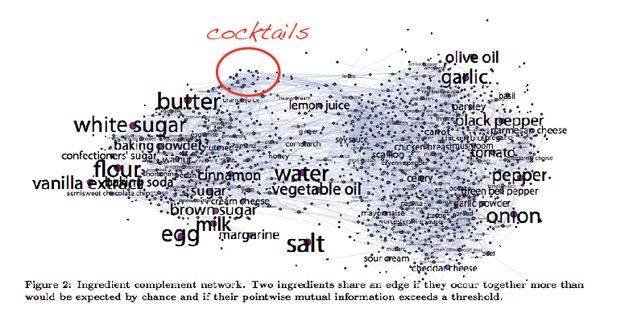A Social Network for Food: Why Won’t Vanilla Friend Garlic?
by
 Having a well-stocked pantry has never been something I’ve had, a fact that is brought home to me every time I’m in my mum’s kitchen. She reaches into her baking cupboard and pulls out all sorts of spices and powders and sugars, and half an hour later has created a cake. Me, on the other hand? Well, I have half a bag of flour, a can of Dominoes granulated sugar, and some brand new baking powder and vanilla extract that I had to run out to the store and buy so I could attempt a batch of cupcakes. By the end of the (two-hour) baking process I had wasted one batch of batter due to forgetting to add the egg before the flour, covered myself and the countertop in said flour, and generated nine slightly over-cooked cupcakes.
Having a well-stocked pantry has never been something I’ve had, a fact that is brought home to me every time I’m in my mum’s kitchen. She reaches into her baking cupboard and pulls out all sorts of spices and powders and sugars, and half an hour later has created a cake. Me, on the other hand? Well, I have half a bag of flour, a can of Dominoes granulated sugar, and some brand new baking powder and vanilla extract that I had to run out to the store and buy so I could attempt a batch of cupcakes. By the end of the (two-hour) baking process I had wasted one batch of batter due to forgetting to add the egg before the flour, covered myself and the countertop in said flour, and generated nine slightly over-cooked cupcakes.
Tales of my culinary incompetence aside, what’s an amateur cook to do when she finds herself without a critical ingredient? Fear not, science to the rescue!
Information technology experts at the University of Michigan and Northeastern University decided to analyze the almost 50,000 recipes on allrecipes.com and asked a couple of key questions. First, why do we cook things at all? Evolutionary biologists have long noted the relationship between our eating habits and the size of our brains in comparison to other apes, suggesting that one likely influenced the other. Teng, Lin, and Adamic looked at the rating system in place on the website and found that recipes that involved cooking were rated higher than those that just involved mixing together a couple of ingredients, playing into the idea that the relative ease of digestion attracts us to processed versus raw foods. They also found that the carbohydrate component of any given recipe was more influential on a rating than other dietary components, implying an intrinsic critical assessment of the high-energy food that we eat.
The authors also compiled a network of the types of foods that complement one another:

Not surprisingly the ingredients clustered nicely into savory versus sweet, and, as I have highlighted, there was a cocktail cluster at around 1 o’clock relative to the desserts. That seems like a good time for a cocktail cluster.
But my favorite part of the analysis was the substitution network. By comparing recipes for similar dishes that contained significantly different ingredients the authors were able to construct networks of interchangeable flavors. For example, if you forgot to get cinnamon at the store but by some quirk of fate you have nutmeg, allspice, or cardamom, then you’re all set. A seemingly bizarre example of these kinds of relationships was the finding that baking powder can frequently be substituted with cream of tartar, but a quick Google search re-affirmed my belief that I may not belong in the kitchen, as I had confused it with tartar sauce.
Hopefully in the near future these data will become accessible and usable to all of us in the form of a searchable website. But until then we will have to rely on the traditional method of substitution by trial and error, and understanding that tartar sauce does not belong in a cupcake.
P.S. My cupcakes weren’t bad once frosted, although my oven is apparently running a little hot. That’s my excuse anyway.
.
Katie Pratt is a graduate student in Molecular Biology at Brown University. She has a passion for science communication, and in an attempt to bring hardcore biology and medicine to everyone, she blogs jargon-free at www.katiephd.com. Follow her escapades in the lab and online on Twitter.
.
.
Be the first one to mind the gap by filling in the blank as a comment and get your name in the blog along with a sweet new BenchFly mug!
Update: Congratulations to Leonardo – winner of this week’s Mind the Gap!
About the winner: Leonardo is a Herpetologist in search of tadpoles, books and the meaning of “Life, universe and everything else”… Currently trying to survive his master’s in a tropical location with too few trees. You can follow him on Twitter @Leoged.
.
About the prize: In addition to fame and glory beyond their wildest dreams, winners receive our new hot-off-the-presses large (15 oz) BenchFly mug to help quench their unending thirst for scientific knowledge… or coffee.
.

Miss a previous edition of Mind the Gap? Shame on you! Don’t worry – we’ve got you covered:
I’d Rather Die Fat and Young than Old and Skinny
Look Into My Wide, Vacant, Eyes
Sweet Relief: How Sugar May Help Reverse Climate Change
Laughter Really is the Best Medicine
All Work and No Play Makes Katie RSI Prone
Sexual Identity and Autocrine Stimulation: Oh, To Be Teenage Yeast
On Wine, Sunburns and the Tendency of Headlines to Mislead
Which Came First: The Opossum or the Snake?
Pigeons Know a Crazy Woman When they See One
To Boldly Go Where No Worm Has Gone Before
Another One Bites the Dust: Rinderpest Eradicated
Scientists Just Wanna Have Fun (Like Uncaged Monkeys)
Mosquitoes Eating You Alive? Cheesy Feet Could be the Problem
.
.
.


Leonardo Gedraite
wrote on December 7, 2011 at 2:15 pm
carb
alan@benchfly
wrote on December 7, 2011 at 2:19 pm
We have a winner! Carbohydrates it is!
Marianne Strnad
wrote on December 7, 2011 at 3:43 pm
Aww man!!! That was my guess, sigh…congrats Leo! Now I'll resume my work of saving lives here at the VA in Seattle…lol!
lescientiste
wrote on December 9, 2011 at 5:48 pm
some think that cooking food increases the ease of digestion as well as the number of nutrients that can be extracted:
http://blogs.discovermagazine.com/crux/2011/12/08…